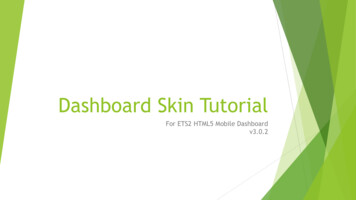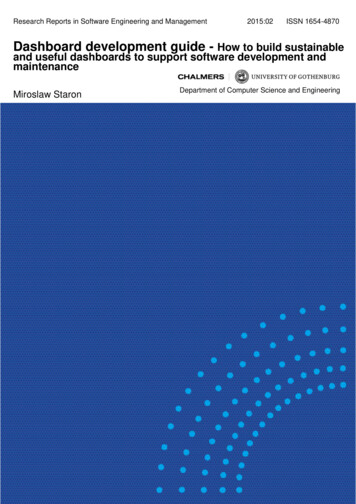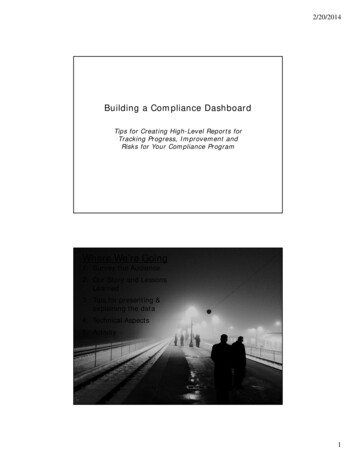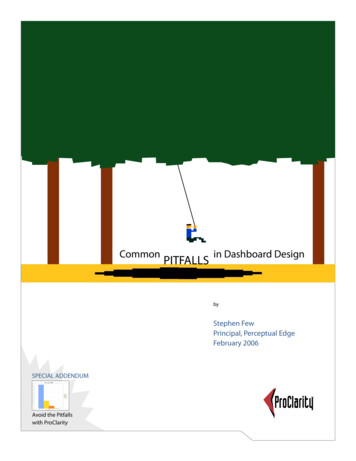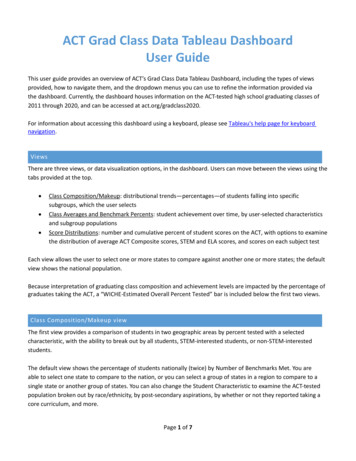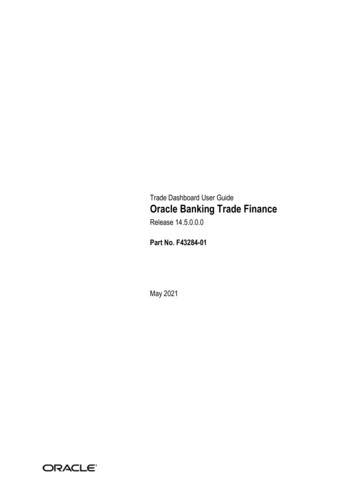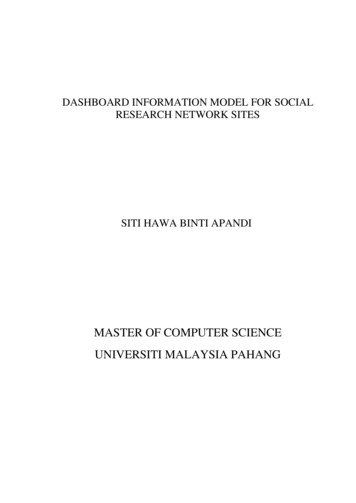
Transcription
DASHBOARD INFORMATION MODEL FOR SOCIALRESEARCH NETWORK SITESSITI HAWA BINTI APANDIMASTER OF COMPUTER SCIENCEUNIVERSITI MALAYSIA PAHANGi
UNIVERSITI MALAYSIA PAHANGDECLARATION OF THESIS AND COPYRIGHTAuthor‟s Full Name: SITI HAWA BINTI APANDIDate of Birth: 12 AUGUST 1989Title: DASHBOARD INFORMATION MODEL FOR SOCIALRESEARCH NETWORK SITESAcademic Session: 2015/2016I declare that this thesis is classified as:CONFIDENTIALRESTRICTEDOPEN ACCESS(Contains confidential information under the OfficialSecret Act 1997)*(Contains restricted information as specified by theorganization where research was done)*I agree that my thesis to be published as online openaccess (Full Text)I acknowledge that Universiti Malaysia Pahang reserve the right as follows:1.2.3.The Thesis is the Property of Universiti Malaysia PahangThe Library of Universiti Malaysia Pahang has the right to make copies for thepurpose of research only.The Library has the right to make copies of the thesis for academic exchange.CertifiedBy:(Student‟s Signature)(Supervisor‟s Signature)ASSOCIATE PROFESSOR DR.RUZAINI BIN ABDULLAH890812-01-5724ARSHAHNew IC/Passport NumberName of SupervisorDate:Date:ii
SUPERVISOR’S DECLARATIONI hereby declare that I have checked this thesis and in my opinion, this thesis is adequatein terms of scope and quality for the award of the degree of Master of ComputerScience.(Supervisor‟s Signature)Full Name: DR. RUZAINI BIN ABDULLAH ARSHAHPosition: ASSOCIATE PROFESSORDate:iii
STUDENT’S DECLARATIONI hereby declare that the work in this thesis is based on my original work except forquotations and summaries which have been duly acknowledged. I also declare that ithas not been previously or concurrently submitted for any other degree at UniversitiMalaysia Pahang or any other institutions.(Author‟s Signature)Full Name: SITI HAWA BINTI APANDIID Number: MCC13003Date:iv
DASHBOARD INFORMATION MODEL FOR SOCIAL RESEARCH NETWORKSITESSITI HAWA BINTI APANDIThesis submitted in fulfillment of the requirementsfor the award of the degree ofMaster of Computer ScienceFaculty of Computer Systems & Software EngineeringUNIVERSITI MALAYSIA PAHANGAUGUST 2016i
TABLE OF CONTENTSPageDECLARATIONTITLE RAKvTABLE OF CONTENTSviLIST OF TABLESxLIST OF FIGURESxiiCHAPTER 1INTRODUCTION1.1Research Background11.2Problem Statement21.3Research Question31.4Research Objectives31.5Research Scope41.6Thesis Organization4CHAPTER 2LITERATURE REVIEW2.1Introduction62.2Platform for Researchers to Support Research Activity72.2.12.2.22.2.31013142.3The Conceptualization of Social MediaThe Conceptualization of Social Networking SitesDifferences between Social Media and SocialNetworking SitesRole of Social Networking Sites in Academic Research Cycle2.4Use of Social Networking Sites by Researchers18vi15
2.5The Conceptualization of Dashboard222.6Implementation of Dashboard for Researchers312.7Dashboard Development Methodology372.8Literature Studies on Relevance of Dashboard to Researcher Needs402.9Conclusion42CHAPTER 3METHODOLOGY3.1Introduction443.2Research Approaches443.3Research sionCHAPTER 4Phase 1: Relevance of Dashboard to Researcher NeedsPhase 2: Identification of Dashboard ItemsPhase 3: Development of Dashboard Information ModelPhase 4: Design the Mock-up Prototyping of DashboardInformation ModelPhase 5: Verification of Dashboard Information Model5661DASHBOARD ITEMS FOR DASHBOARDINFORMATION MODEL4.1Introduction624.2Findings on The Relevance of Dashboard to Support The Researcher62Needs4.34.4Findings on The Identification of Dashboard Items664.3.14.3.267694.3.3ConclusionCHAPTER 5Dashboard Items Identified from Literature StudiesDashboard Items Identified from the Social ResearchNetwork SitesProposed Dashboard Items7173DEVELOPMENT OF DASHBOARD INFORMATIONMODEL5.1Introduction75vii
5.2Pretesting Finding755.3Survey Results and Analysis825.3.1835.4Background Information of Respondents in the ActualSurvey5.3.2Grouping of Dashboard Items Using Factor Analysis5.3.3Internal Consistency Reliability5.3.4Differences in Perception of Dashboard Items betweenSenior and Junior ResearchersDevelopment of Dashboard Information Model for Researchers in the8699102103Social Research Network Sites5.5Conclusion112CHAPTER 6VERIFICATION OF DASHBOARD INFORMATIONMODEL6.1Introduction1136.2Verification Result of Dashboard Information Model Based on114Analysis of Interview6.3Discussion1266.4Summary128CHAPTER earch Contributions1317.47.3.1Contribution to Theory7.3.2Contribution to PracticeFurther Research131133133REFERENCES135APPENDICES143A143The Survey on Dashboard Items in Social Research Network Sites forResearchersBThe Interview Protocol154viii
Section ASection BCThe Brief Introduction of This Research StudyThe Development and Description of DashboardInformation ModelSection C The Mock-Up Prototyping for the DashboardInformation ModelSection D The Interview Questions for the Dashboard InformationModelSection E The Questions about Respondent InformationList of Publicationsix155158160171174175
LIST OF TABLESTableTitlePage2.1Difference between social media and social networking sites142.2Difference between general social networking sites and SocialResearch Network Sites222.3Description of dashboard characteristics243.1Comparison of research approaches453.2The research operational framework in this study473.3List of questions in feedback form of the survey523.4Parts in the survey533.5Description of factors of End-User Computing Satisfaction603.6Some of the interview questions designed in this study based on thequestions in the content factor of EUCS604.1Researcher needs634.2Dashboard purposes644.3Relationship between dashboard purposes and researcher needs664.4List of dashboard items identified from literature studies674.5Comparison of dashboard items identified based on review of SocialResearch Network Sites704.6Comparison of dashboard items identified from literature studiesand based on review of Social Research Network Sites714.7Proposed dashboard items identified based on analysis fromliterature studies and based on review of Social Research NetworkSites735.1Background information of the respondents in the pretesting765.2Findings on content validity of the survey805.3Changes in the survey after pretesting81x
5.4Background information of the respondents participated in the actualsurvey835.5Correlation matrix875.6KMO and Bartlett‟s test905.7Anti-image correlation matrix915.8Total variance explained945.9Rotated component matrix965.10Result of re-run factor analysis965.11Interpretation on result of re-run factor analysis985.12Reliability statistics for Factor 11005.13Item-total statistics for Factor 11005.14Reliability statistics for Factor 21005.15Item-total statistics for Factor 21005.16Reliability statistics for Factor 31015.17Item-total statistics for Factor 31015.18Re-run reliability statistics for Factor 31015.19Re-run item-total statistics for Factor 31015.20Differences in perception of dashboard items between group ofresearchers1036.1Result regarding verification of the dashboard information model1206.2Comparison of finalized dashboard information model with SocialResearch Network Sites127xi
LIST OF FIGURESFigureTitlePage2.1Framework of literature review in this study72.2Relation of social media and social networking sites92.3Academic research cycle162.4Example of dashboard interface262.5Example of dashboard interface with alert mechanisms272.6Interface of alerts282.7Real-time feature to monitor the results of an Internet marketingcampaign292.8Drill-down feature on category sales to view monthly sales trend302.9Interface of PUSHPIN application322.10Interface of widget-based dashboard (AWESOME)332.11Screenshot of researcher profile in ResearchGate342.12Screenshot of Analytics feature in Academia.edu352.13Screenshot of Mendeley readership statistics of an article362.14Screenshot of researcher profile in Google Scholar Citations372.15Requirement identification phase in dashboard developmentmethodology382.16Intelligence phase in dashboard development methodology392.17Formation of phase 1 and phase 2 in methodology used in this study403.1Steps taken in the first phase493.2A model of End-User Computing Satisfaction instrument595.1Total respondents based on faculties785.2Percentage of respondents use Social Research Network Sites78xii
options in the pretesting5.3Percentage of respondents use Social Research Network Sites845.4Percentage of respondents use Social Research Network Sitesoptions855.5Percentage of respondents know about dashboard855.6Scree plot955.7Groups of dashboard items1055.8Dashboard information model for researchers in Social ResearchNetwork Sites1065.9Dashboard component researcher performance (M1) in thedashboard information model1075.10Dashboard component impact of researcher publication (M2) in thedashboard information model1095.11Dashboard component research events alert (M3) in the dashboardinformation model1116.1Modified dashboard component researcher performance (M1) in thedashboard information model1186.2Finalized dashboard information model for researchers in SocialResearch Network Sites125B.1Process work in this study157B.2Dashboard information model for researchers in Social ResearchNetwork Sites159B.3Screen design for dashboard component researcher performance(M1)162B.4Screen design for co-author details163B.5Screen design for conference paper details164B.6Screen design for journal article details165B.7Screen design for dashboard component impact of researcherpublication (M2)167B.8Screen design for dashboard component research events alert (M3)to see list of upcoming conference169xiii
B.9Screen design for dashboard component of research events alert(M3) to see list of journal publication platformsxiv170
DASHBOARD INFORMATION MODEL FOR SOCIAL RESEARCH NETWORKSITESSITI HAWA BINTI APANDIThesis submitted in fulfillment of the requirementsfor the award of the degree ofMaster of Computer ScienceFaculty of Computer Systems & Software EngineeringUNIVERSITI MALAYSIA PAHANGAUGUST 2016i
ABSTRACTThe Social Research Network Sites (SRNS) is an online platform used byresearchers for research related activities. Due to huge amounts of information in thecurrent SRNS, sometimes this information overwhelms the researchers. A researchrelated dashboard information model is proposed to minimize the information overflowin the SRNS and it provides awareness on research-related information. The analysis onthe relevance of having a dashboard has been done, and the results shows that it is asignificant tool in assisting the researcher needs on monitoring their own researchperformance, monitoring research trends and alerting them with upcoming events. Theproposed dashboard items that are possible to be included in the dashboard informationmodel are identified based on analysis from literature studies and by review on thecurrent SRNS. A survey was conducted in order to validate the dashboard items. Basedon the result of factor analysis, the dashboard items can be grouped into three which arepublication impact, publication achievements and alert on upcoming events. From thethree group of the dashboard items, the dashboard information model is developed thathas three dashboard components which are researcher performance (M1), impact ofresearcher publication (M2) and research events alert (M3). Then, we design a mock-upprototyping which represent the dashboard information model. The mock-upprototyping has been used for the dashboard information model verification purposethrough interview with selected researchers. The result from the interview has shownthat the researchers accepted and intended to use the mock-up prototyping thatrepresenting the dashboard information model. A few suggestions for enhancement ofthe dashboard items to be included in the dashboard information model have beenreceived from the feedbacks. The dashboard information model that has beenestablished is useful to be embedded in SRNS in order to aware the researchers on theresearch-related information. The embedded of the dashboard information model in theSRNS can attract more users to use the SRNS. The developers of SRNS can utilize thedashboard information model as a guideline in developing a better SRNS for theresearchers.iv
ABSTRAKSocial Research Network Sites (SRNS) adalah platform dalam talian yangdigunakan oleh penyelidik untuk aktiviti berkaitan penyelidikan. Disebabkan jumlahmaklumat yang besar dalam SRNS, kadang-kadang maklumat ini menyesakkanpenyelidik. Sebuah model maklumat dashboard berkaitan penyelidikan dicadangkanuntuk mengurangkan limpahan maklumat dan ia dapat memberikan kesedaran tentangmaklumat berkaitan penyelidikan. Analisis perkaitan mempunyai dashboard telahdilakukan, dan keputusan menunjukkan bahawa ia adalah alat yang penting dalammembantu keperluan penyelidik memantau prestasi penyelidikan mereka sendiri,memantau trend penyelidikan dan mengingatkan mereka dengan acara tentangpenyelidikan yang akan datang. Cadangan dashboard items untuk dimasukkan ke dalammodel maklumat dashboard dikenal pasti berdasarkan analisis daripada kajian sasteradan kajian pada SRNS. Satu kaji selidik telah dijalankan untuk mengesahkan dashboarditems. Berdasarkan hasil analisis faktor, dashboard items boleh dikumpulkan ke dalamtiga iaitu impak penerbitan, pencapaian penerbitan dan kesedaran tentang acaraberkaitan penyelidikan yang akan datang. Daripada tiga kumpulan dashboard items,model maklumat dashboard dibangunkan yang mempunyai tiga komponen dashboardiaitu prestasi penyelidik (M1), impak penerbitan penyelidik (M2) dan kesedaran tentangacara penyelidikan (M3). Kemudian, kami mereka bentuk prototaip mock-up untukmewakili model maklumat dashboard. Prototaip mock-up digunakan untuk tujuanpengesahan model maklumat dashboard melalui temu bual dengan penyelidik yangdipilih. Hasil daripada temu bual itu telah menunjukkan bahawa para penyelidik dapatmenerima dan mahu untuk menggunakan prototaip mock-up yang mewakili modelmaklumat dashboard. Terdapat beberapa cadangan tentang penambahan dashboarditems untuk dimasukkan ke dalam model maklumat dashboard telah diterima daripadamaklumbalas para penyelidik. Model maklumat dashboard boleh digunakan untukdimasukkan ke dalam SRNS untuk memastikan para penyelidik sedar tentang maklumatberkenaan penyelidikan. Kemasukan model maklumat dashboard dalam SRNSmembolehkan menarik lebih ramai pengguna menggunakan SRNS. Pembangun SRNSboleh menggunakan model maklumat dashboard sebagai garis panduan dalammembangunkan SRNS yang lebih baik untuk para penyelidik.v
REFERENCESAbrizah, A., Badawi, F., Zoohorian-Fooladi, N., Nicholas, D., Jamali, H.R. and Norliya,A.K. (2014). What scholarly channels and resources do authors trust to read, citeand publish in? A Malaysian study. ICOLIS 2014, pp. 245-262.Alhoori, H. and Furuta, R. (2011). Understanding the dynamic scholarly research needsand behavior as applied to social reference management. Research andAdvanced Technology for Digital Libraries, pp. 169-178.Baez, M., Mirylenka, D. and Parra, C. (2011). Understanding and supporting search forscholarly knowledge. Proceeding of the 7th European Computer ScienceSummit, 1-8.Bose, R. (2006). Understanding management data systems for enterprise performancemanagement. Industrial Management & Data Systems, 106(1), 43-59.boyd, d.m. and Ellison, N.B. (2008). Social network sites: Definition, history, andscholarship. Journal of Computer‐Mediated Communication, 13(1), 210-230.Bullinger, A.C., Hallerstede, S.H., Renken, U., Soeldner, J.-H. and Moeslein, K.M.(2010). Towards research collaboration – a taxonomy of Social ResearchNetwork Sites. Proceedings of the Sixteenth Americas Conference onInformation Systems (AMCIS), pp. 1-9.Cann, A., Dimitriou, K. and Hooley, T. (2011). Social media: A guide for researchers.London: Research Information Network.Chakraborty, N. (2012). Activities and reasons for using social networking sites byresearch scholars in NEHU: A study on Facebook and ResearchGate. 8thConvention PLANNER-2012, pp. 19-27.Collins, E. and Hide, B. (2010). Use and relevance of Web 2.0 resources forresearchers. Publishing in the Networked World: Transforming the Nature ofCommunication 14th International Conference on Electronic Publishing, pp.271-289.135
Creswell, J.W. (2012). Educational research: planning, conducting, and evaluatingquantitative and qualitative research (4th ed.). Pearson.Creswell, J.W. (2013). Research design: Qualitative, quantitative, and mixed methodsapproaches. Sage publications.Day, N. (2007). Achieving user satisfaction in content management systems. MasterThesis. Lancaster University, United Kingdom.Department of Materials Science & Metallurgy, University of Cambridge. (n.d.).Eligibility criteria for early-stage researchers and experienced researchers cam.ac.uk/department/eligibility.php on 15 August 2014.Doll, W.J. and Torkzadeh, G. (1988). The measurement of end-user computingsatisfaction. MIS quarterly, 12(2), 259-274.Dourish, P. and Bellotti, V. (1992). Awareness and coordination in shared workspaces.Proceedings of the 1992 ACM conference on Computer-supported cooperativework, pp. 107-114.Few, S. (2006). Information dashboard design. O'Reilly.Giglia, E. (2011). Academic social networks: It‟s time to change the way we doresearch. European Journal of Physical and Rehabilitation Medicine, 47(2),345-349.Grimm, P. (2010). Pretesting a questionnaire. Wiley International Encyclopedia ofMarketing, 1.Gross, T., Stary, C. and Totter, A. (2005). User-centered awareness in computersupported cooperative work-systems: structured embedding of findings fromsocial sciences. International Journal of Human-Computer Interaction, 18(3),323-360.Gruzd, A. and Goertzen, M. (2013). Wired Academia: Why social science scholars areusing Social Media. 2013 46th Hawaii International Conference on SystemSciences (HICSS), pp. 3332-3341.Gruzd, A., Staves, K. and Wilk, A. (2012). Connected scholars: Examining the role ofsocial media in research practices of faculty using the UTAUT model.Computers in Human Behavior, 28(6), 2340-2350.136
Hariyanti, E. (2008). Pengembangan metodologi pembangunan information dashboarduntukmonitoringkinerjaorganisasi. KonferensidanTemuNasionalTeknologi Informasi dan Komunikasi untuk Indonesia, pp.Hogan, B. and Quan-Haase, A. (2010). Persistence and change in social media. Bulletinof Science, Technology & Society, 30(5), 309-315.Jones, A.W. (2003). Impact factors of forensic science and toxicology journals: Whatdo the numbers really mean? Forensic Science International, 133(1), 1-8.Kalb, H., Bukvova, H. and Schoop, E. (2009). The digital researcher: Exploring the useof social software in the research process. Sprouts: Working Papers onInformation Systems, 9(34), 1-11.Kaplan, A.M. and Haenlein, M. (2010). Users of the world, unite! The challenges andopportunities of Social Media. Business horizons, 53(1), 59-68.Keinonen, T. (n.d.). Theory of a design goal: Usability of interactive products (online).Retrieved from http://www.uiah.fi/projects/metodi/158.htm on 15 August 2014.KENPRO. (2012). Sample size determination using Krejcie and Morgan table (online).Retrieved from ing-krejcieand-morgan-table/ on 19 July 2016.Kostoulas, A. (2014). How to interpret ordinal data (online). Retrieved o-interpret-ordinal-data/ on 19February 2016.Kumar, A. and Kumar, R. (2013). Use of Social Networking Sites (SNSs): A study ofMaharishi Dayanand University, Rohtak, India. Library Philosophy andPractice (e-journal), 1-12.Li, N. and Gillet, D. (2013). Identifying influential scholars in academic social mediaplatforms. Proceedings of the 2013 IEEE/ACM International Conference onAdvances in Social Networks Analysis and Mining (ASONAM), pp. 608-614.Lietz, P. (2010). Research into questionnaire design. International Journal of MarketResearch, 52(2), 249-272.Liman, M.A., Ibrahim, M.B. and Gana, I.A. (2013). Evaluating measurement model forvalues inculcation in mathematical contents delivery. Educational Research,4(1), 31-41.137
Lindland, O.I. (1993). A prototyping approach to validation of conceptual models ininformation systems engineering. Ph.D. Thesis. The Nowegian Institute ofTechnology (NTH), Trondheim, Norway.Litwin, M.S. (1995). How to measure survey reliability and validity. Sage.Lövstrand, L. (1991). Being selectively aware with the khronika system. Proceedings ofthe Second European Conference on Computer-Supported Cooperative Work,pp. 265-277.Madhusudhan, M. (2012). Use of social networking sites by research scholars of theUniversity of Delhi: A study. The International Information & Library Review,44(2), 100-113.Mahendrawathi, E., Pranantha, D. and Utomo, J.D. (2010). Development of dashboardfor hospital logistics management. 2010 IEEE Conference on Open Systems(ICOS), pp. 86-90.Maheshwari, D. and Janssen, M. (2013). Measurement and benchmarking foundations:Providing support to organizations in their development and growth usingdashboards. Government Information Quarterly, 30, S83-S93.Malik, S. (2005). Enterprise dashboards: Design and best practices for IT. John Wiley& Sons.Manikandan, S. (2011). Measures of dispersion. Journal of Pharmacology andPharmacotherapeutics, 2(4), 315.Masud, S., Afrin, M., Choudhury, F.M. and Ahmed, S.I. (2012). VizResearch: Linkingthe knowledge of people and the people with knowledge. Procedia ComputerScience, 9, 1416-1425.Mathur, V.P. and Sharma, A. (2009). Impact factor and other standardized measures ofjournal citation: A perspective. Indian Journal of Dental Research, 20(1), 81-85.Mohammadi, E., Thelwall, M., Haustein, S. and Larivière, V. (2014). Who readsresearch articles? An altmetrics analysis of Mendeley user categories. Journal ofthe Association for Information Science and Technology, 66(9), 1832–1846.Morton-Owens, E.G. and Hanson, K.L. (2012). Trends at a glance: A managementdashboard of library statistics. Information Technology and Libraries, 31(3), 3651.Nández, G. and Borrego, Á. (2013). Use of social networks for academic purposes: Acase study. The Electronic Library, 31(6), 781-791.138
Nentwich, M. and König, R. (2014). Academia goes Facebook? The potential of socialnetwork sites in the scholarly realm. Opening Science. 107-124. SpringerInternational Publishing.O'Leary, D.E. (2008). The relationship between citations and number of downloads inDecision Support Systems. Decision support systems, 45(4), 972-980.Orts, D. (2004). Dashboard development and deployment: A methodology for success.Washington: Noetix Corporation.Osborne, F., Motta, E. and Mulholland, P. (2013). Exploring scholarly data withrexplore. The Semantic Web–ISWC 2013. 460-477. Springer.Othman, M.S., Suhaimi, S.M., Yusuf, L.M., Yusof, N. and Mohamad, N. (2012). Ananalysis of social network categories: Social learning and social friendship.Procedia-Social and Behavioral Sciences, 56, 441-447.Parsian, N. (2009). Developing and validating a questionnaire to measure spirituality: Apsychometric process. Global Journal of Health Science, 1(1), 2-11.Pauwels, K., Ambler, T., Clark, B.H., LaPointe, P., Reibstein, D., Skiera, B., Wierenga,B. and Wiesel, T. (2009). Dashboards as a service: Why, what, how, and whatresearch is needed? Journal of Service Research, 12(2), 175-189.Perneger, T.V., Courvoisier, D.S., Hudelson, P.M. and Gayet-Ageron, A. (2015).Sample size for pre-tests of questionnaires. Quality of Life Research, 24(1), 147151.Phippen, A., Sheppard, L. and Furnell, S. (2004). A practical evaluation of Webanalytics. Internet Research, 14(4), 284-293.Priem, J., Piwowar, H.A. and Hemminger, B.M. (2012). Altmetrics in the wild: Usingsocial media to explore scholarly impact. arXiv preprint arXiv:1203.4745, 1-18.Procter, R., Williams, R., Stewart, J., Poschen, M., Snee, H., Voss, A. and AsgariTarghi, M. (2010). Adoption and use of Web 2.0 in scholarly communications.Philosophical Transactions of the Royal Society A: Mathematical, Physical andEngineering Sciences, 368(1926), 4039-4056.Radhakrishna, R.B. (2007). Tips for developing and testing ruary/tt2.php on 18 December 2014.Ramsden, P. (1994). Describing and explaining research productivity. HigherEducation, 28(2), 207-226.139
Reinhardt, W. (2012). Awareness support for knowledge workers in research networks.Ph.D. Thesis. Open University in the Netherlands (CELSTEC), Heerlen, TheNetherlands.Reinhardt, W., Kadam, P., Varlemann, T., Surve, J., Ahmad, M.I. and Magenheim, J.(2012a). Supporting scholarly awareness and researchers‟ social interactionsusing PUSHPIN. Proceedings of the 2nd workshop on awareness and reflectionin technology-enhanced learning, CEUR Workshop Proceedings, pp. 31-46.Reinhardt, W. and Mletzko, C. (2011). Awareness in learning networks. Proceedings ofthe PLE Conference 2011, pp. 12-20.Reinhardt, W., Mletzko, C., Drachsler, H. and Sloep, P.B. (2014). Design andevaluation of a widget-based dashboard for awareness support in ResearchNetworks. Interactive Learning Environments, 22(5), 594-613.Reinhardt, W., Mletzko, C., Sloep, P.B. and Drachsler, H. (2012b). Understanding themeaning of awareness in Research Networks. Proceedings of the 2nd Workshopon Awareness and Reflection in Technology Enhanced Learning, pp. 13-30.Richter, A. and Koch, M. (2008). Functions of social networking services. Proc. Intl.Conf. on the Design of Cooperative Systems, pp. 87-98.Rohani, V.A. and Ow, S.H. (2011). Eliciting essential requirements for social networksin academic environments. 2011 IEEE Symposium on Computers & Informatics(ISCI), pp. 171-176.Rowlands, I., Nicholas, D., Russell, B., Canty, N. and Watkinson, A. (2011). Socialmedia use in the research workflow. Learned Publishing, 24(3), 183-195.Smith, D. (2010). Using Social Networking tools to promote genealogy and localhistory collections and to instruct researchers in their use. World Library andInformation Congress: 76th Ifla General Conference and Assembly, pp. 1-13.Suryatiningsih, Bambang, H. and Arie, A.S. (2011). The development methodology ofoperational dashboard as a tool for organizational performance monitoring (Acase study: Telkom Polytechnic). Proceedings of The 1st InternationalConference on Information Systems For Business Competitiveness (ICISBC)2011, pp. 183-191.Tabachnick, B. and Fidell, L. (1996). Using Multivariate Statistics, 3rd ednHarperCollins. New York.140
Tang, J., Zhang, D. and Yao, L. (2007). Social network extraction of academicresearchers. Seventh IEEE International Conference on Data Mining (ICDM),pp. 292-301.Tang, J., Zhang, J., Yao, L., Li, J., Zhang, L. and Su, Z. (2008). Arnetminer: Extractionand mining of academic social networks. Proceedings of the 14th ACMSIGKDD international conference on knowledge discovery and data mining, pp.990-998.Taprial, V. and Kanwar, P. (2012). Understanding Social Media. Bookboon.Thelwall, M. and Kousha, K. (2014). Academia.edu: Social Network or AcademicNetwork? Journal of the Association for Information Science and Technology,65(4), 721-731.Thelwall, M. and Kousha, K. (2015). ResearchGate: Disseminating, communicating,and measuring Scholarship? Journal of the Association for Information Scienceand Technology, 66(5), 876–889.tools4dev. (n.d.). How to pretest and pilot a survey questionnaire (online). w-to-pretest-and-pilot-a-survey-questionnaire/ on 15 October 2014.Treude, C. and Storey, M. (2010). Awareness 2.0: staying aware of projects, developersand tasks using dashboards and feeds. 2010 ACM/IEEE 32nd InternationalConference on Software Engineering, pp. 365-374.Vickery, G. and Wunsch-Vincent, S. (2007). Participative web and user-createdcontent: Web 2.0 wikis and social networking. Organization for EconomicCooperation and Development (OECD).Wang, W.-T., Wang, B. and Wei, Y.-T. (2014). Examining the impacts of websitecomplexities on user satisfaction based on the task-technology fit model: Anexperimental research using an eyetracking device. Pacific Asia Conference onInformation System (PACIS) 2014 Proceedings, pp. 1-8.Webster, J. and Watson, R.T. (2002). Analyzing the past to prepare for the future:Writing a literature review. Management Information Systems Quarterly, 26(2),13-23.West, D.M. (2012). Big data for education: Data mining, data analytics, and webdashboards. Governance Studies at Brookings, 1-10.141
Xiao, L. and Dasgupta, S. (2002). Measurement of user satisfaction with web-basedinformation systems: An empirical study. AMCIS 2002 Proceedings, pp. 11491155.Yan, E. and Ding, Y. (2012). A framework of studying scholarly networks. Proceedingsof the 17th International Conference on Science and Technology Indicators, pp.917-926.Yigitbasioglu, O.M. and Velcu, O. (2012). A review of dashboards in performancemanagement: Implications for design and research. International Journal ofAccounting Information Systems, 13(1), 41-59.Zainal, H. and Hussin, A.R.C. (2013). A model for measuring Web OPAC end usersatisfaction. Journal of Information Systems Research and Innovation 98-107.142
B.2 Dashboard information model for researchers in Social Research Network Sites 159 B.3 Screen design for dashboard component researcher performance (M1) 162 B.4 Screen design for co-author details 163 B.5 Screen design for conference paper details 164 B.6 Screen design for journal article details 165 B.7 Screen design for dashboard component .
